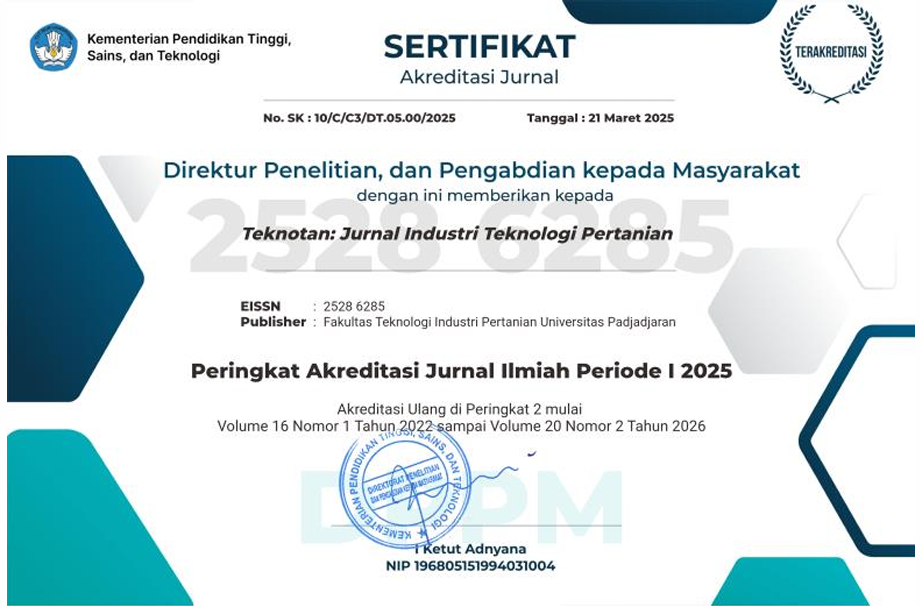Pengaruh Rasio Bahan-Pelarut dan Waktu Ekstraksi terhadap Mutu Ekstrak Tembakau (Nicotiana tabacum L.) dengan Microwave-Assisted Extraction (MAE)
Abstract
Tembakau (Nicotiana tabacum L.) merupakan salah satu komoditas unggulan di Indonesia. Ekstrak tembakau dapat diaplikasikan dalam produk untuk membantu berhenti merokok. Metode ekstraksi berbantu microwave (MAE) memiliki keunggulan dalam mempersingkat waktu ekstraksi dan penggunaan energi serta penggunaan pelarut yang lebih efektif. Penelitian ini bertujuan mengetahui pengaruh waktu ekstraksi dan rasio bahan baku-pelarut terhadap rendemen, warna, kandungan alkaloid, serta kadar nikotin pada ekstrak tembakau menggunakan Microwave-Assisted Extraction (MAE). Hasil analisis menunjukkan bahwa rasio 1:3 (b/v) memerlukan waktu lebih lama untuk mencapai rendemen tinggi, sedangkan rasio 1:9 (b/v) mampu menghasilkan rendemen yang lebih besar dalam waktu yang lebih singkat. Warna ekstrak tembakau menunjukkan nilai L*, a*, dan b* yang bervariasi, kecenderungan warna mengarah ke merah gelap. MAE menghasilkan kadar nikotin yang lebih rendah dibandingkan maserasi, tetapi tetap lebih efektif karena dapat mencapai hasil yang mendekati hanya dalam waktu ekstraksi 15 menit. Rasio bahan bakupelarut dan waktu ekstraksi terbukti memengaruhi rendemen, warna, dan kandungan alkaloid pada ekstrak tembakau. Perlakuan dengan hasil rendemen tertinggi (29.54%) serta intensitas sedang senyawa alkaloid yang terdeteksi diperoleh dari rasio bahan baku-pelarut 1:9 (b/v) selama 5 menit.
Keywords
Full Text:
PDF (Bahasa Indonesia)References
Al-Dahhan, W. H., Kadhom, M., Yousif, E., Mohammed, S. A., & Alkaim, A. (2022). Extraction and Determination of Nicotine in Tobacco from Selected Local Cigarettes Brands in Iraq. Letters in Applied NanoBioScience, 11(1), 3278–3290. https://doi.org/10.33263/LIANBS111.32783290
Banožić, M., Banjari, I., Flanjak, I., Paštar, M., Vladić, J., & Jokić, S. (2021). Optimization of MAE for the Separation of Nicotine and Phenolics from Tobacco Waste by Using the Response Surface Methodology Approach. Molecules, 26(14). https://doi.org/10.3390/molecules26144363
Benowitz, N. L. (2010). Nicotine Addiction. N Engl J Med, 362(24), 2295–2303. https://doi.org/10.1056/NEJMra0809890.Nicotine
Cundiff, R. H., & Markunas, P. C. (1955). Determination of Nicotine, Nornicotine, and Total Alkaloids in Tobacco. Analytical Chemistry, 27(10), 1650–1653. https://doi.org/10.1021/ac60106a048
Dahmoune, F., Nayak, B., Moussi, K., Remini, H., & Madani, K. (2015). Optimization of microwave-assisted extraction of polyphenols from Myrtus communis L. leaves. Food Chemistry, 166, 585–595. https://doi.org/10.1016/j.foodchem.2014.06.066
Ditjenbun. (2021). Statistik Perkebunan Unggulan Nasional 2020-2022. In Sekretariat Direktorat Jendral Perkebunan. Sektertariat Direktorat Jenderal Perkebunan, Kementrian Pertanian.
Dobrinčić, A., Repajic, M., Elez Garofulić, I., Tuđen, L., Dragović-Uzelac, V., & Levaj, B. (2020). Comparison of Di ff erent Extraction Methods for the. Processes, 8(9), 1008.
Firdausiah, S., Firdaus, Hamdayanty, Hidayat, T., & Alfliadhi, M. (2020). The Comparison of Three Different Methods on Extraction of Cigarette Butt as Natural Insecticide. Indonesia Chimica Acta, 13(2), 55–59.
Gorrod, J. W., & Jacob, P. (1999). Analytical Determination of Nicotine and Related Compounds and Their Metabolites. In Analytical Determination of Nicotine and Related Compounds and their Metabolites. https://doi.org/10.1016/b978-044450095-3/50005-x
Guo, J., Zhao, N., Zhao, Y., Jin, H., Sun, G., Yu, J., Zhang, H., Shao, J., Yu, M., Yang, D., & Liang, Z. (2024). The Extraction Using Deep Eutectic Solvents and Evaluation of Tea Saponin. Biology, 13(6), 1–15. https://doi.org/10.3390/biology13060438
Harborne, J. B. (1998). Phytochemical Methods A guide to modern techniques qf plant analysis. In Chapman & Hall (Vol. 21, Issue 8). https://doi.org/10.1016/0305-1978(93)90098-c
Hutchings, J. B. (1999). Food Colour and Appearance. In Cha. https://doi.org/10.1016/s0963-9969(97)89646-9
Kurniatri, A. A., Yunarto, N., Oktoberia, I. S., Winarsih, Setyorini, H. A., & Reswandaru, U. N. (2020). Raw Material of Nicotine Isolated From Tobacco Leaves Cultivated in Indonesia. Atlantis Press, 22(Ishr 2019), 133–135. https://doi.org/10.2991/ahsr.k.200215.026
Meng, Y., Wang, Y., Guo, W., Lei, K., Chen, Z., Xu, H., Wang, A., Xu, Q., Liu, J., & Zeng, Q. (2024). Analysis of the relationship between color and natural pigments of tobacco leaves during curing. Scientific Reports, 14(1), 1–10. https://doi.org/10.1038/s41598-023-50801-1
Moldoveanu, S. C., Scott, W. A., & Lawson, D. M. (2016). Nicotine Analysis in Several Non-Tobacco Plant Materials. Contributions to Tobacco Research, 27(2), 54–59. https://doi.org/10.1515/cttr-2016-0008
Ng, L. K., & Hupé, M. (2003). Effects of moisture content in cigar tobacco on nicotine extraction: Similarity between Soxhlet and focused open-vessel microwave-assisted techniques. Journal of Chromatography A, 1011(1–2), 213–219. https://doi.org/10.1016/S0021-9673(03)01178-6
Nour, A. H., Oluwaseun, A. R., Nour, A. H., Omer, M. S., & Ahmed, N. (2021). Microwave-Assisted Extraction of Bioactive Compounds (Review). In Microwave Heating - Electromagnetic Fields Causing Thermal and Non-Thermal Effects (p. 202). https://doi.org/10.5772/intechopen.87921
Oeung, S., & Yin, V. (2017). Phytochemical analysis of different extracts of leaves of Nicotiana tabacum L. of Cambodia. Asian Journal of Pharmacognosy, 1(3), 18–26. https://www.researchgate.net/publication/322063419
Ozturk, B., Parkinson, C., & Gonzalez-Miquel, M. (2018). Extraction of polyphenolic antioxidants from orange peel waste using deep eutectic solvents. Separation and Purification Technology, 206, 1–13. https://doi.org/10.1016/j.seppur.2018.05.052
Putri, R. H., Barid, I., & Kusumawardani, B. (2014). Daya Hambat Ekstrak Daun Tembakau terhadap Pertumbuhan Mikroba Rongga Mulut. Stomatognatic, 11(02), 27–31.
Sihombing, R. P., Tamba, A. P., Renata, C. A., & Ngatin, A. (2022). Ekstraksi Daun Tembakau dengan Metode MAE (Microwave Assisted Extraction) dengan Variasi Jenis Pelarut dan Waktu Ekstraksipada Daya Microwave 150 Watt. Prosiding The 13th Industrial Research Workshop and National Seminar, 13–14.
Sun, B., Tian, Y. X., Zhang, F., Chen, Q., Zhang, Y., Luo, Y., Wang, X. R., Lin, F. C., Yang, J., & Tang, H. R. (2018). Variations of alkaloid accumulation and gene transcription in Nicotiana tabacum. Biomolecules, 8(4). https://doi.org/10.3390/biom8040114
Tassew, Z., & Chandravanshi, B. S. (2015). Levels of Nicotine in Ethiopian Tobacco Leaves. SpringerPlus, 4(1). https://doi.org/10.1186/s40064-015-1448-y
Wang, J., Sheehan, M., Brookman, H., & Timko, M. P. (2000). Characterization of cDNAs differentially expressed in roots of tobacco (Nicotiana tabacum cv Burley 21) during the early stages of alkaloid biosynthesis. Plant Science, 158(1–2), 19–32. https://doi.org/10.1016/S0168-9452(00)00293-4
Wu, R., Tian, Z., Zhang, C., Li, D., Tian, N., Xing, L., Ma, L., & Jiang, Z. (2022). Uniformity evaluation of stem distribution in cut tobacco and single cigarette by near infrared spectroscopy. Vibrational Spectroscopy, 121(January), 103401. https://doi.org/10.1016/j.vibspec.20
DOI: https://doi.org/10.24198/jt.vol19n2.9
Refbacks
- There are currently no refbacks.
Indexed by:

This work is licensed under a Creative Commons Attribution 4.0 International License (CC BY-SA 4.0)


1.png)
.png)







